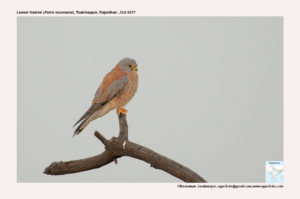Lesser-kestrel

Lesser Kestrel Falco naumanni
Etymology:
- Falco : Latin for Falcon based on Sickle shaped claws ( falcis- sickle)
- Naumanni : Named after German ornithologist Johann Friedrich Naumann (1780–1857)
Vernacular Names: Guj: Nani laraji, Mar: Chota Kharuchi
Distribution in India: Widespread passage migrant in India.
Description: Size of 29-32 cm. It’s unspotted above; greater upperwing-coverts are blue-grey; underparts are less spotted. The female generally is more uniformly coloured and more heavily spotted, lacking grey areas; barred tail; with white claws; central two rectrices protrude slightly. The juvenile is almost identical to female.
Habitat: It is found in open areas in hot, dry climates; little or low vegetation, e.g. steppe, pastures, semi desert, extensive cultivation; also in and around towns. Breeds up to 1500 m and in migration reached 3000 m.
Food Habits: It eats aerial and terrestrial insects like beetles, grasshoppers, locusts, crickets; other invertebrates like earthworms, small lizards ,rodents like voles, mice, shrews and small birds and their fledglings. Flies low, stooping on prey in air or on ground; typically faces into wind and hangs without beating wings, or hovers briefly; also hunts from perch or even on ground. Hunts in groups following swarming insects. Takes advantage of prey disturbed by grass or scrub fires, or by tractors turning soil. Prefers fallow land as foraging habitat.
Breeding Habits: They breed in May in North West Africa and April in South Spain. They nest mainly in human constructions in towns or on outskirts; also in natural sites, like rock faces, clay banks and quarries, and occasionally in old corvid nest. They lay a clutch of 3–6, laid at intervals of 1–2 days. If first clutch lost a replacement laying occurs. The incubation period is 26–29 days, starting with last egg, by both adults but mainly female. The chicks are born altricial. The chicks are fed by female. The fledging period is 36 days and attain independence one week later.